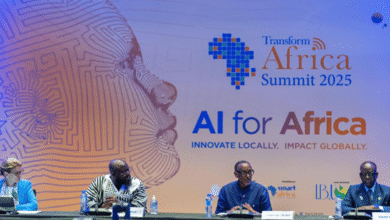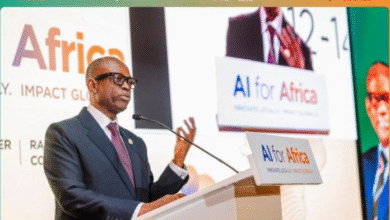Bridging the Gap : transport infrastructure as Africa’s economic catalyst
In this opinion piece, Ayodeji Stephen, specialist in hydrogen and e-mobility, highlights the central role of transport infrastructure as a crucial lever for African economic development. According to him, addressing the current deficits is an urgent priority to promote growth, regional integration, social inclusion, and environmental sustainability.

By Ayodeji Stephen*
Africa’s economic potential hinges on its ability to move goods, people, and ideas efficiently—yet its transport infrastructure remains a critical bottleneck. Poor roads, aging rail systems, and underdeveloped ports stifle trade, limit job creation, and undermine sustainability across the continent.
More than 640 million Africans have no access to energy, giving an electricity access rate for African countries at just over 40 percent—the world’s lowest (AfDB, 2015). This goes to show the level of infrastructure deficit present in the African landscape of economic development.
The World Bank estimates that inadequate transport infrastructure slashes Africa’s productivity by up to 40%, a staggering loss that keeps economies fragmented and globally uncompetitive. Conversely, efficient transport networks, spanning roads, railways, and ports, can unlock significant gains: boosting GDP, linking rural producers to urban markets, and supporting green goals like reduced emissions.
The African Continental Free Trade Area (AfCFTA), launched in 2021, amplifies this urgency, with projections of a 28% rise in freight demand by 2030 (UNECA, 2022). Meanwhile, global decarbonisation trends demand sustainable solutions, including electric vehicles and low-carbon rail, to align Africa with climate commitments.
This brief argues that strategic investments in sustainable transport infrastructure are not just an option but a necessity to unleash Africa’s economic potential. By focusing on high priority areas like connectivity and innovation, the continent has the unique advantage of turning its infrastructure deficit into a driver of growth, trade, and resilience.
Africa’s Transport Infrastructure Gap
Africa’s economic potential is vast, but it remains hampered by a deep-seated barrier: weak transport infrastructure. While home to some of the planet’s most rapidly expanding economies and rapidly growing populations, the continent’s transport backbone remains weak.
This weakness is most starkly apparent in its road infrastructure. Research shows that only 47% of African roads are paved, a figure lesser than the global average (World Bank, 2010). Such a low coverage of road infrastructure hinders access to markets, health, education, and employment—especially rural and landlocked territories.
The effects are widespread. Bad road networks add to the cost of trade, both national and international. Commodities shipped over long distances are bogged down by routine delays arising from poor roads, check-points, and slow border crossings.
Intra-African trade is among the most expensive in the world, according to the World Bank (World Bank, 2010). Transport costs in Africa are 63% greater than in industrialised countries. Transport costs account for 30% to 50% of the continent’s entire export value, compared to an average of 17% in other emerging countries (AfDB, 2013).
UNCTAD affirms that at 11.4% of the value of imports, African countries paid more for international transport than any other region in 2005–2014. Not so much has changed since then. This exorbitant transport makes African businesses less competitive and diminishes the attractiveness of regional integration, something very important for fulfilling the targets of the AfCFTA (UNECA, 2022).
On top of this, African cities have increasingly inadequate, aging transport infrastructure. Cities such as Lagos, Nairobi, and Kinshasa struggle daily with congestion, inefficient public transport, and high levels of accidents (UN-Habitat, 2020).
These issues have the greatest impacts on poor areas, who must endure long, costly commutes. Lack of investment in infrastructure for non-motorised modes of transport like sidewalks and cycling lanes also denies mobility and perpetuates social exclusion.
Besides economic inefficiencies and social injustice, the infrastructure deficit has an environmental cost. Africa’s heavy reliance on old, fuel-guzzling vehicles and deteriorated road networks translates into higher emissions of greenhouse gases and air pollutants (AfDB, 2022).
Urban transport emissions are rising exponentially, compounded by excessive idling in slow traffic (IEA, 2021). With little investment in rail or clean transport modes, the African region risks committing itself to carbon-intensive transport systems, which go against its climate goals under the Paris Agreement.
Sealing the transport infrastructure gap in Africa is not just a question of economic development—it’s one of social inclusion, environmental sustainability, and regional integration.
The solution lies in a comprehensive, multi-stakeholder approach that encompasses increased public investment, innovative financing arrangements (e.g., public-private partnerships), and robust policy environments favoring inclusive, low-carbon transport systems.
Particularly, expansion of investment in climate-resilient road construction, more rail and mass transit infrastructure, and promoting digital technologies for logistics management can help bridge the gap. Harmonisation of transport policies within regions to facilitate free cross-border movement of goods and people is also very important.
The challenge of transport infrastructure in Africa is great but not insurmountable. By proper planning and collective effort, the continent can transform its roads, rail network, and transit systems into the drivers of inclusive growth and sustainable development.
Leveraging Transport for Growth
It is likely the most immediate benefit of increased transport infrastructure, which comes from connectivity and trade. Better roads, contemporary railways, efficient ports, and computerised logistical networks are required to realise this promise.
Improved infrastructure allows easier cross-border trade, minimises delays, lowers logistical costs, and connects manufacturers to wider markets, especially in landlocked and rural places (UNECA, 2022).
Effortless connectivity between African countries may free up billions of dollars in commerce, raise GDP, and drive investment in industrial and agricultural value chains (AfDB, 2022).
Aside from economic efficiency, transport infrastructure provides a strong foundation for green innovation. With the current global climate crisis, Africa can accelerate its growth by investing in low-carbon transportation.
Increased usage of electric vehicles (EVs), combined with hydrogen-powered freight and mass transit, as well as infrastructure that allows for walking, cycling, and clean public transportation, can significantly reduce emissions (IEA, 2022).
These will contribute to Africa’s climate ambitions under the Paris Agreement, create green jobs, improve urban air quality, and reduce reliance on fossil fuel imports (AfDB, 2022).
Equally important is the role of youth engagement in shaping Africa’s sustainable transport future. With over 60% of Africa’s population under the age of 25, investing in the skills, creativity, and leadership of young professionals is a strategic priority (United Nations, 2023).
Involving youth in transport planning, policy design, digital mobility innovations, and green infrastructure development fosters ownership, ensures long-term resilience, and creates pathways to employment in emerging sectors.
From local start-ups building mobility apps to engineering students piloting solar-powered buses, youth are already transforming the transport space across the continent.
| Opportunity | Action | Economic Impact | Environmental Impact | Youth Engagement |
| Trade Connectivity | Upgrade roads, rail, and ports | +8% GDP by 2035 | N/A | +2 million jobs |
| Green Innovation | Deploy EVs and hydrogen transport | +500,000 green tech jobs | -25 million tons CO₂ by 2030 | Training and upskilling in green tech |
| Smart Infrastructure | Integrate IoT and data analytics | +33% trade efficiency | -10% fuel use in urban transport | Innovation hubs and digital labs |
Africa’s Transport Potential in Action
Africa’s transport potential is already being served by visionary ventures and future innovation. An example is the Trans-African Highway (TAH) network, an ongoing project still in progress to connect major cities and economic hubs of the continent.
Made up of nine highways spanning over 60,000 kilometers, the TAH network is poised to enhance regional integration, reduce transportation time and price, and enhance cross-border commerce (AUC, 2014).
By linking landlocked countries to seaport terminals and harmonising road networks, this network supports the aspirations of the AfCFTA and serves as a template model for regional integration (UNECA, 2022).
Apart from these traditional infrastructure projects, Africa is also experiencing a surge in intelligent infrastructure solutions that combine technology with transport systems.
For instance, Internet of Things (IoT) technology is being used in city traffic management systems in Kigali and Nairobi (World Bank, 2021). IoT technologies use sensors, GPS, and real-time data analytics to monitor jams, optimise traffic movement, and increase commuter satisfaction.
These innovations not only address urban mobility challenges but also draw attention from Africa’s growing population of tech-savvy youth (UNHabitat, 2020).
They also reveal modalities in which a hybrid approach that combines mega-infrastructure with digital innovation is able to yield both short-term and long-term benefits.
To transform Africa’s transport infrastructure into a driver of economic growth, a strategic, sustainable, and inclusive policy framework is critical. These recommendations provide a roadmap for impactful, future-ready transport systems.
1. Invest Strategically in High-Impact Projects
African governments should prioritise transboundary initiatives like the 69 priority projects under the Programme for Infrastructure Development in Africa (PIDA), which promise rapid, scalable benefits (AUC, 2014).
Closing the $100 billion annual infrastructure funding gap (AfDB, 2022) demands innovative public-private partnerships (PPPs). Legal frameworks, tax incentives, and credit guarantees can de-risk investments, attracting private capital to projects like the Trans-African Highway, enhancing connectivity.
2. Promote Green and Climate-Resilient Infrastructure
Integrate sustainability into every transport project—from using recycled materials in road construction to investing in electric buses and rail systems. National climate action plans should be aligned with transport infrastructure strategies.
3. Harmonise Regional Transport Policies
Africa’s 55 countries need unified regulatory frameworks to facilitate free movement of goods and people. Streamlined customs procedures, interoperable vehicle regulations, and coordinated transport policies within regional economic communities will reduce delays and costs.
4. Empower Youth and Women
Provide training, entrepreneurship support, and leadership programs to boost participation of youth and women in transport sectors. Innovation hubs and incubators can foster new ideas for sustainable urban mobility and freight logistics.
5. Harness Technology and Data
Support the deployment of smart infrastructure, including real-time traffic management, electronic tolling, and digital freight tracking. Policies should encourage open data sharing, cybersecurity, and digital inclusion.
Conclusion: Africa’s Infrastructure Challenge Is an Opportunity
Africa stands at a crossroads. With one of the fastest urbanisation rates and youngest populations globally, the continent’s infrastructure deficit is a huge challenge but also a once-in-a-generation opportunity.
Transport infrastructure is the backbone of economic integration, social inclusion, and climate resilience. Investing wisely and strategically today can unlock Africa’s full potential by:
- Boosting intra-African trade and GDP
- Reducing costs and delays in moving goods and people
- Creating millions of decent jobs in construction, green tech, and digital innovation
- Delivering low-carbon, inclusive, and resilient transport solutions
- Empowering youth and women as drivers of sustainable mobility
The call to action is clear: African governments, the private sector, development partners, and civil society must join forces to accelerate infrastructure development and innovation.
By bridging the transport gap, Africa can power its economic transformation and lead on the global stage towards a prosperous, inclusive, and sustainable future.
*Ayodeji Stephen is a specialist in hydrogen and e-mobility, focused on infrastructure development. He is a PhD candidate at Dublin City University researching transport decarbonization.
Read the full report : https://theelectricityhub.com/wp-content/uploads/2025/05/Bridging-the-Gap-Transport-Infrastructure-as-Africas-Economic-Catalyst.pdf






